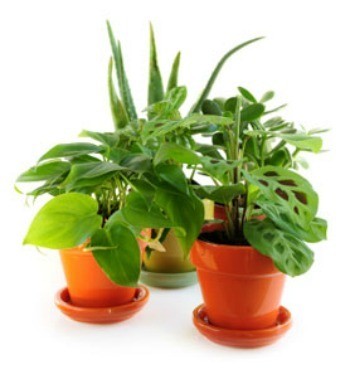
The end of a summer vacation can come as a shock to some, especially to the tropical houseplants we put out on the deck and patio to reinvigorate over the summer. Once temperatures start to dip into the mid-40s (in some cases 50s), they start to risk becoming injured from the cold. Moving them from full sun and chilly nights spent outdoors to a dim and toasty room indoors can be quite a shock. Here's how to safely reintroduce them to life indoors for the winter.
A week or so before moving your full sun plants back indoors, move them into the shade. Even the sunniest window inside your home receives lower light than your plants have been used to getting outdoors. By transitioning them to an area receiving less light before moving them indoors, you're likely to see fewer yellow or dropped leaves from the sudden adjustment to a different light intensity. This will also help them prepare for changes in humidity, air circulation, and temperature. Hint: This is also a great time to clean your windows-both inside and out!
Give your houseplants a good cleaning by removing any dead or damaged leaves, or spent flowers. Follow that up with a gentle shower from the garden hose. This is a great way to dislodge the first round of bugs and dust off their leaves before bringing them inside.
Once indoors, insect problems that went unnoticed all summer can suddenly spiral out of control. To prevent this, inspect the stems and leaves of your plants (including the undersides) diligently. Submerging smaller plants in a 5-gallon bucket of water for 15 minutes is a great way to send insect scrambling for higher ground. This shouldn't be done with plants that go semi-dormant or dormant in the winter (e.g. succulents, bulbous plants), as these plants need dry soil throughout their dormant period.
If insects are problem, treat plants with the appropriate organic insecticidal soap or horticultural spray. Repeat the treatments as directed (usually several days or weeks). Once you finally move them indoors, as an added precaution you should continue to isolate them from the plants in the rest of your house for several weeks.
In necessary, repot crowded or leggy plants into new containers. Leggy plants can be removed from their containers and pruned (roots and tops) in equal proportions. Make sure you scrub the pots thoroughly and replant them in fresh, sterilized potting soil.
Plants tend to receive less light and therefore most grow more slowly once they are brought back indoors. Now is the time to reduce the strength and frequency of your fertilizing regime. If your plants go into a semi-dormant or dormant state over the winter, stop fertilizing completely and resume fertilizing once you see signs of new growth.
Humidity levels tend to be much lower indoors than outdoors. This is especially true once our furnaces kick in. As your plants adjust to life back inside, it may be beneficial to mist them frequently or set them on a humidity tray (a tray filled with water and pebbles). As the water evaporates, it will raise the humidity around the plants.
Overwatering is the fastest way to kill a houseplant. Outdoor potted plants may have required frequent (even daily) watering during sunny, breezy days. Now that they are back indoors, they don't need as much water-especially during rainy, or cloudy fall weather as they won't get enough light to dry out. Always let the surface of the soil get dry to the touch between watering.

About The Author: Ellen Brown is an environmental writer and photographer and the owner of Sustainable Media, an environmental media company that specializes in helping businesses and organizations promote eco-friendly products and services. Contact her on the web at http://www.sustainable-media.com
Add your voice! Click below to comment. ThriftyFun is powered by your wisdom!
Thanks for the info. I always dread wintertime because I'm afraid I'll lose my plants. I'll be sure and use your tips this winter. Do you have any tips on keeping Boston ferns indoors without losing all their leaves?
I've heard stories of people bringing in their plants for winter and unknowingly bringing snakes in with them. Is there a way to check for snakes without putting yourself at risk? Say, something you can do to them to chase out any snakes beforehand?
Before bringing my plants in for the winter and also keeping them healthy throughout the winter months, I slosh soapy water all over them. I usually use Dawn dish washing detergent. I've used this on impatiens and it keeps the bugs off.
I have found my houseplants do much better inside if I put a plant light on them. I did it his year for the 1st time.
Add your voice! Click below to comment. ThriftyFun is powered by your wisdom!